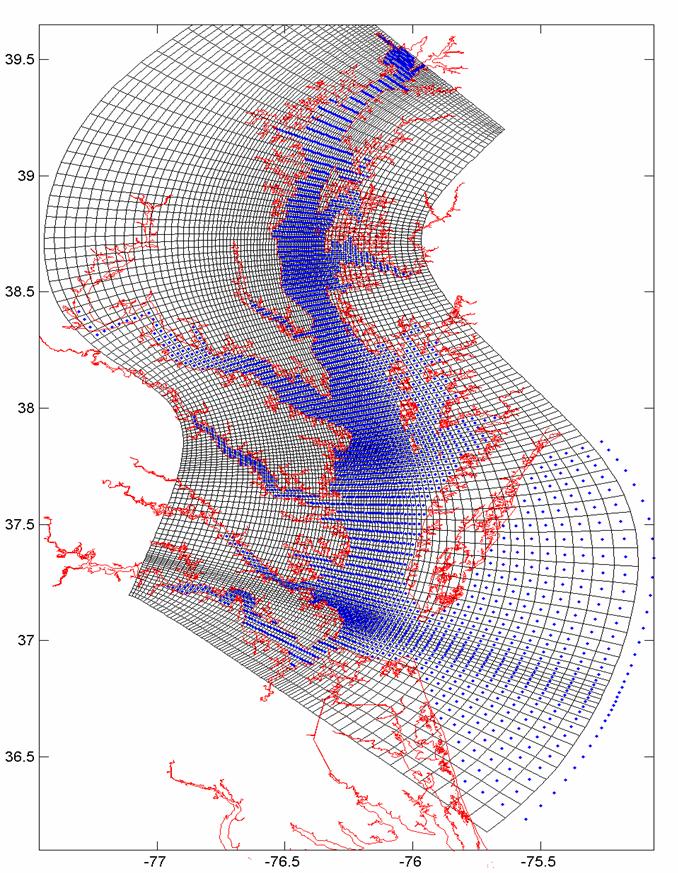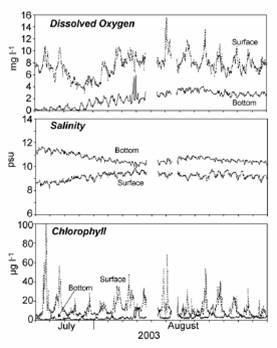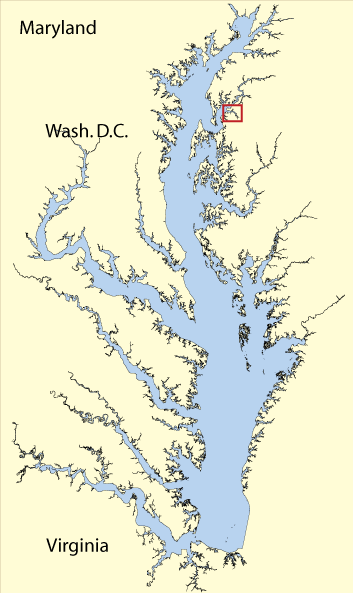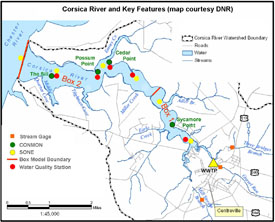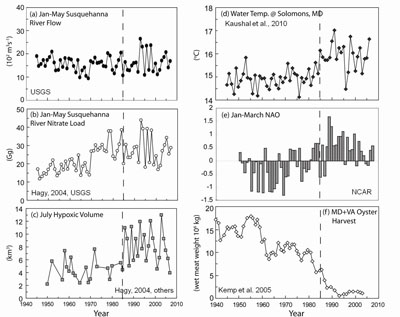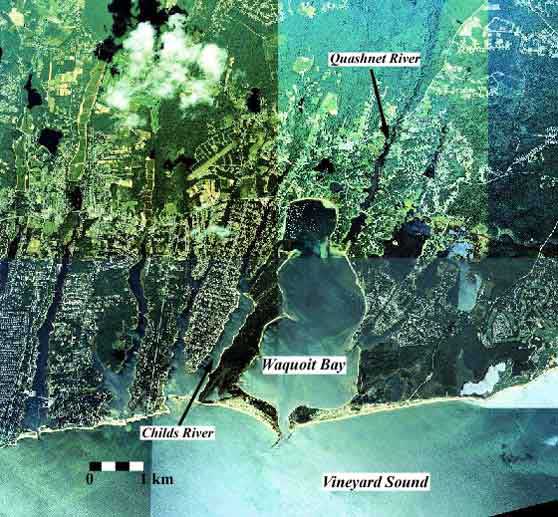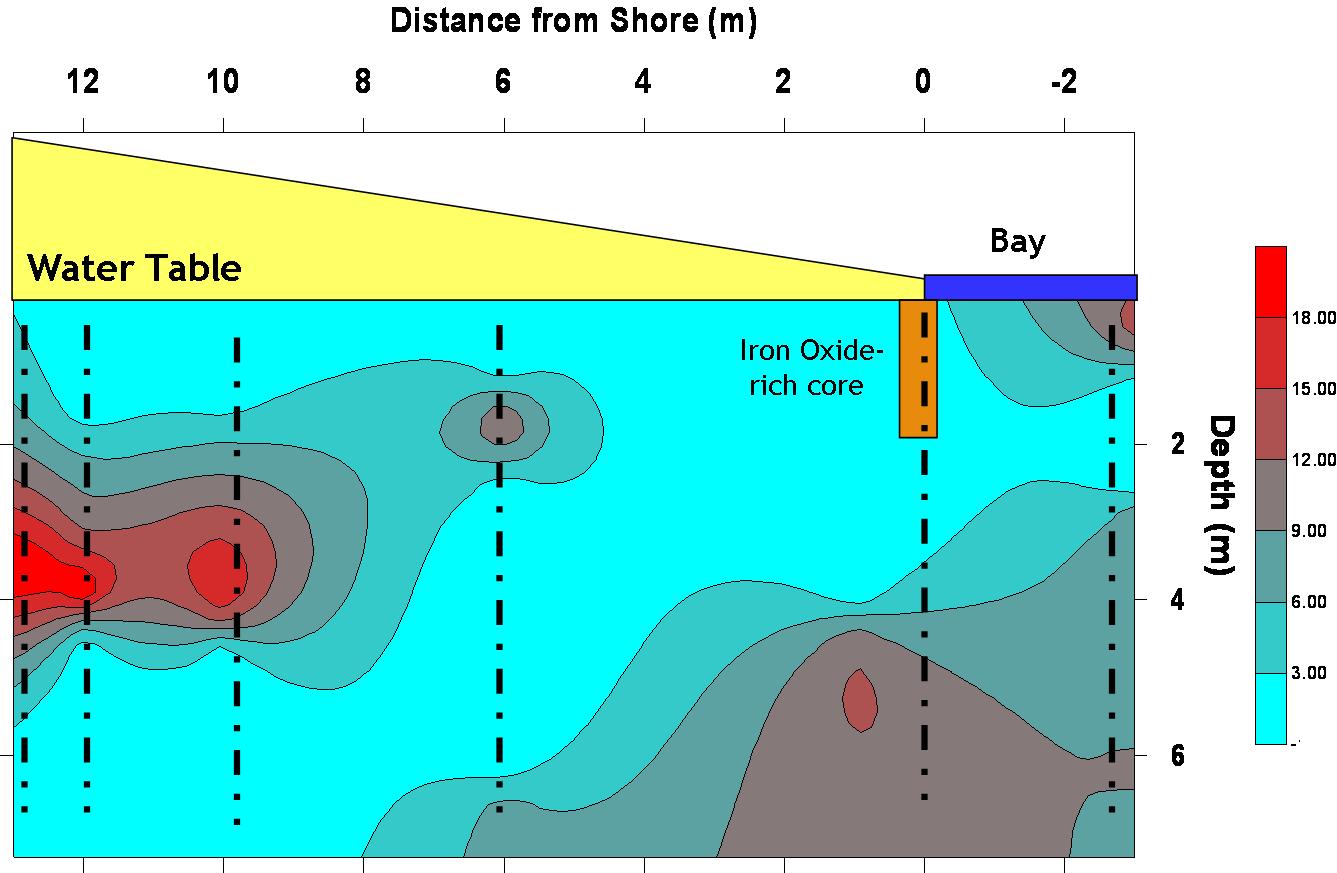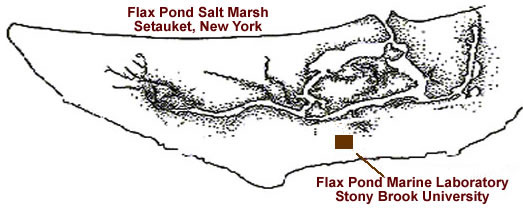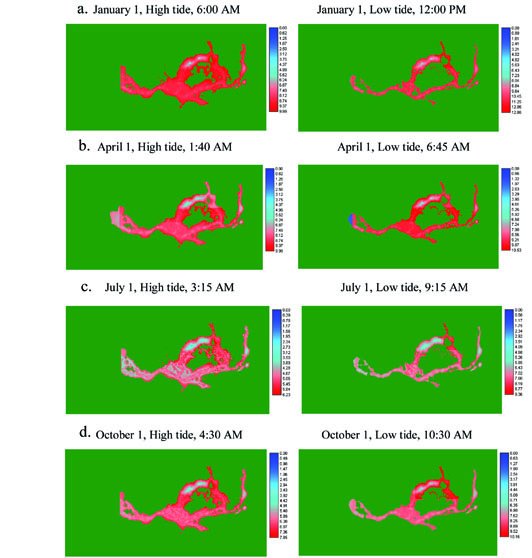Modeling Hypoxia Responses to Climate and NutrientsThe aim of this project is to combine historical data analysis with coupled biogeochemical-hydrodynamic model runs to understand the interacting influences of nutrient loading and climatic variability on dissolved oxygen dynamics in Chesapeake Bay. My focus within this project is to understand feedbacks between low oxygen levels (hypoxia and anoxia) and nutrient cycling, the dependence of hypoxia on winter-spring bio-physical conditions, and to perform scenario runs with a biogeochemical model coupled to an implementation of ROMS (Regional Ocean Modeling System, map to right) in Chesapeake Bay. This modeling work aims to understand how physical forcing and biogeochemical processes impact short -term changes in dissolved oxygen. For example, a mixing event in the Patuxent River estuary caused a 1-2 day alleviation of hypoxia in deep water, while tidal advection and mixing led to semi-diurnal variations in bottom oxygen (figure on right, data from ACT) Publications:
|
Funding Provided by the National Oceanic and Atmospheric Administration CHRP Program |
Predicting Spatial Impacts of Bivalve Aquaculture on Nutrient Cycling and Benthic Habitat Quality (BASIS)I am working with Damian Brady to implement an intermediate-complexity sediment process model to simulate the effects of bivalve (oyster, mussel) biodeposits on sediment biogeochemistry in Chesapeake Bay and coastal Maine aquaculture operations. My work is in support of the broader BASIS project, whose aim is to understand the spatial and temporal effects of bivalve aquaculture, an industry with the potential to increase rapidly in coming decades, on sediment habitat. This project combines physical and biogeochemical field studies with modeling tools to develop quantitative metrics to guide site-selection for aquaculture operations, with a focus on optimizing productivity and minimizing adverse ecological impacts. Collaborators: Roger Newell, Jeff Cornwell, Larry Sanford, John Richardson, Carter Newell, Steve Suttles, and Mike Owens
|
Funding Provided by Maryland Sea Grant |
Watershed-Estuarine Interactions: An Analysis of the Corsica/Chester River Estuarine SystemThe goal of this project is to perform a comprehensive analysis of the Corsica River estuary and its status with respect to watershed uses and nutrient loading. The Corsica River is a small, shallow (mean depth = 1 m) tributary of the Chester River (see map right, photo courtesy of Mark Trice). A second goal is to develop a model to calculate advective and dispersive transport of a conservative tracer (salt) and of non-conservative ecologically important materials (nutrients, organic matter, oxygen) along axis of the Corsica River estuary and between the Corsica and Chester River estuaries. In addition, the model will compute net biogeochemical production (or consumption) at regional and seasonal scales, providing an independent approach to compare to field measurements of nutrient regeneration, denitrification and ecosystem metabolism. This model will be used to generate nutrient and organic carbon budgets for the Corsica/Chester estuarine system, and to consider scenarios related to nutrient management plans. A map of the Corsica River estuary (bottom left) indicates the intensive water quality monitoring in the estuary. A meta-analysis of chlorophyll-a versus nitrogen loading relationships in the Corsica estuary and many other shallow, turbid estuaries of Chesapeake Bay indicates a tight, but non-linear relationship, where algal biomass is most sensitive to nutrient load at intermediate nitrogen loading (figure bottom right). Collaborators: W. Michael Kemp, Walter Boynton, Jeff Cornwell, Eva Bailey, Cindy Palinkas, Maureen Brooks, and Mike OwensPublication:
|
Funding Provided by Maryland Department of Natural Resources |
Development of a Chesapeake Bay Environmental ObservatoryIn this project, an interdisciplinary team of computer scientists, ecologists, oceanographers and environmental engineers are developing and deploying a Chesapeake Bay Environmental Observatory (CBEO) to demonstrate the transformative power of cyberinfrastucture (CI). In a region with a rich history of both management directives and research initiatives that has fostered an existing sensory network, archived data, and intensive modeling efforts, the project team aims to resolve questions regarding the controls over the Chesapeake Bay hypoxic volume over decadal time-scales using analyses of large, integrated data sets (see right). Publications: |
Funding Provided by the National Science Foundation
|
Box Model Analysis of the Patuxent River Estuary, Chesapeake Bay, MarylandThis project's goal was to make box model computations for the Patuxent estuary using 20 years (1985-2004) of water quality monitoring data (left figure). A "Box Model" is a series of linear equations to solve water and salt balances for controlled volumes in an estuarine system, the solutions to which are parameters that characterize the mean advective and non-advective flows in the system. These monthly mean transport calculations for 11 boxes (6 surface boxes (left panel) and 5 bottom boxes) were coupled to a water quality data set to compute the net transport of nitrogen, phosphorus, organic carbon, silica, and oxygen. Residuals of mass balances of these nutrients in each box represents the net production rate of each variable. Seasonal cycles of these net production rates characterize the major seasonal biogeochemical processes in the system (right panel). Collaborators: Michael Kemp, Walter Boynton, Jim HagyPublications: |
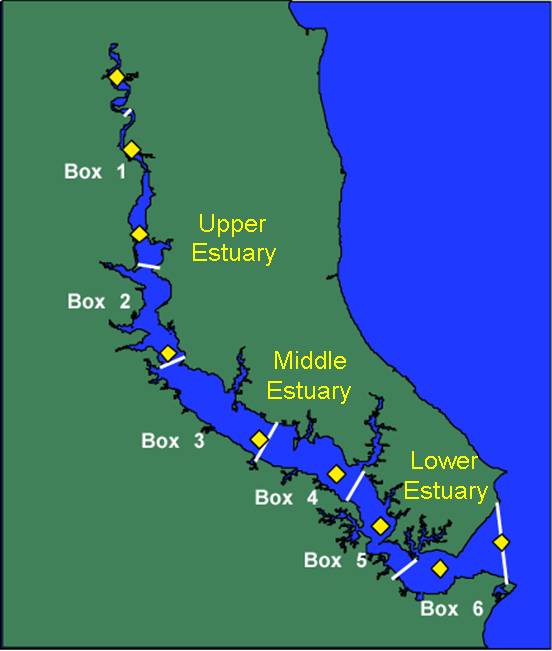 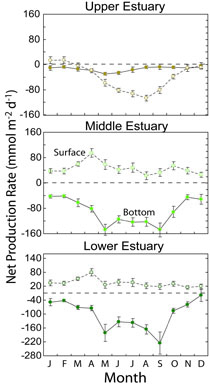 |
Dissolved Iron Cycling the Subterranean Estuary of Waquoit Bay, MassachusettsIn this project, I investigated the cycling on dissolved iron in the saltwater-groundwater exchange zone underlying the beach at the head of Waquoit Bay (top panel). We wanted to test the hypothesis that rapid iron precipitation occurred in this mixing zone, where low-oxygen groundwater met relatively oxygenated seawater, causing the precipitation of Fe(II) into various iron oxyhydroxides. We thus sampled groundwater along a transect perpendicular to the beach up to depths of 10 meters using peizometers. We measured the concentrations dissolved iron, oxygen, and key inorganic nutrients at ~1 meters depth intervals at each station along the transect. We discovered a plume of of dissolved Fe(II) that appeared to rise vertically and attenuate as it approached the salt wedge of water from beneath Waquoit Bay (bottom contour figure). The plume of iron dissipated not as it mixed with salty water, but apparently from interaction with a shallow plume of oxygenated water at roughly 2 meters. Research into this topic has continued in Matt Charette's group at the Woods Hole Oceanographic Institution. This work was part of a Research Experience for Undergraduates, funded by the National Science Foundation
Collaborators: Matt Charette, Ed Sholkovitz, Matt Allen, Craig HerboldPublications:
|
|
Modeling Flax Pond Dissolved Oxygen DynamicsThe goal of this project was to build a dissolved oxygen model in Flax Pond, which is a small tidal salt pond on the northern shore of Long Island (top figure on right). The model computed oxygen every 15 minutes in a 1 meter grid that was coupled to GIS to allow for a spatial representation of the dynamics, which can be extreme due to the shallow and productive nature of Flax Pond, coupled to high flushing of the pond during each tidal cycle (bottom figure on right). For example, the shallow depths of low tide allowed for high areal primary production to rapidly elevate oxygen to high levels (red areas in bottom figure on right during October), while low tide in the early morning of July, with high temperatures allowed respiration to rapidly deplete oxygen to low levels (blue areas in bottom figure on right). this work was done as part of my honors thesis at the State University of New York College of Environmental Science.
Collaborators: Charlie Hall, Myrna HallReport: Testa, J.M. 2003. Simulating Spatial and Temporal Fluctuations of Dissolved Oxygen in Flax Pond, New York, USA. Honors Thesis, The State University of New York College of Environmental Science and Forestry.
|
|

